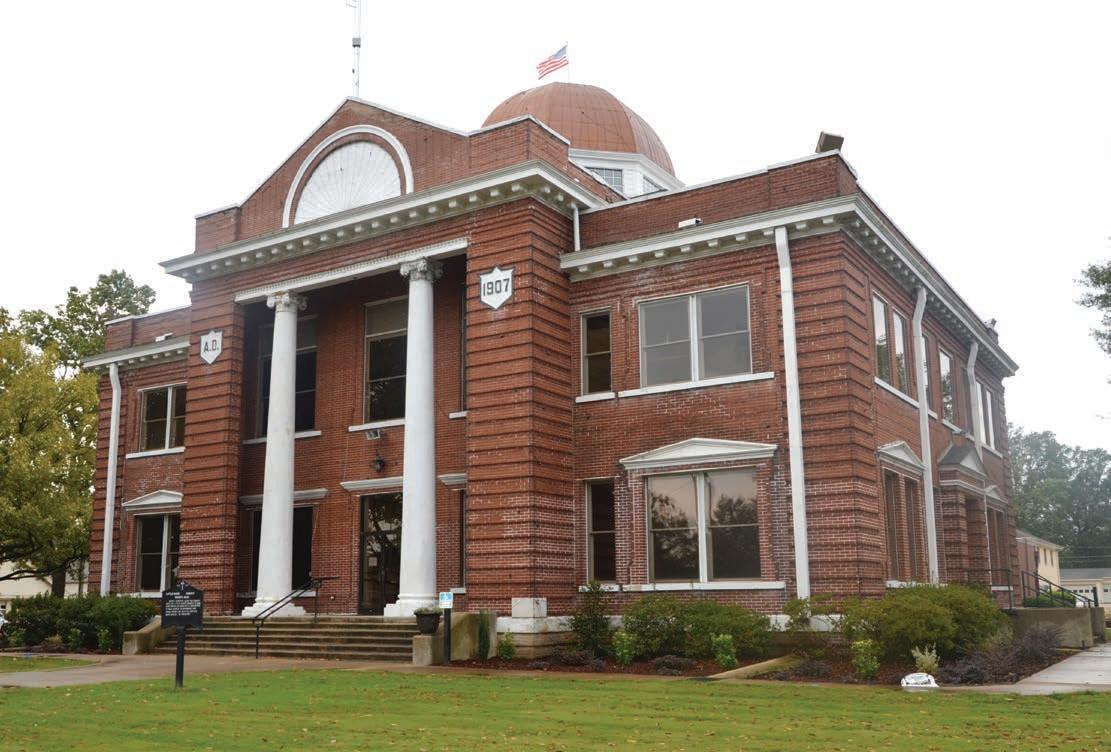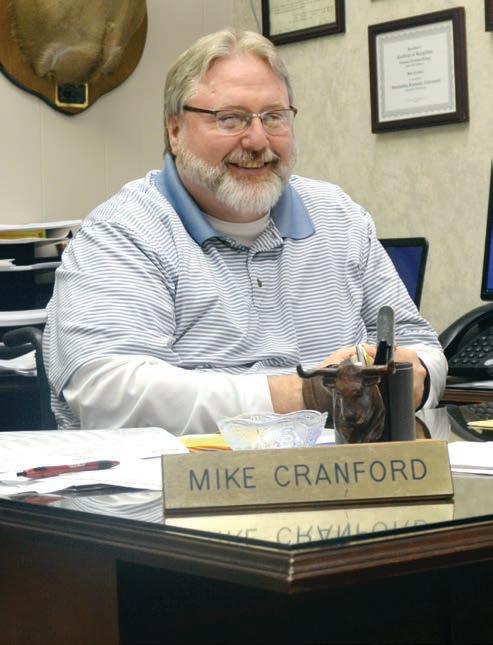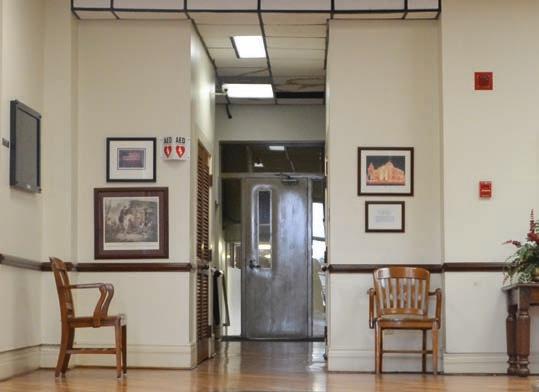
10 minute read
AAC director named to National Council of County Executives board
AAC’s Villines named to National Council of County Association Executives board
Chris Villines, executive director of the Association of Arkansas Counties, recently was named third vice-president of the National Council of County Association Executives (NCCAE) board. NCCAE is an official affiliate of the National Association of Counties (NACo). As third vice-president, Villines will assume the role of president in 2019.
“It’s an honor to serve the NCCAE in a position of leadership,” said Villines. “County association executives are by far one of the most hardworking and welcoming group of people I’ve ever engaged, and we provide constant help to one another to seek out new and better ways to make our state associations more effective. It will be my privilege to serve my fellow executive directors in this capacity and I look forward to sharing with them the good things we are doing here in Arkansas.”
According to Jamie Richards, liaison to the NACo executive committee and board, NCCAE provides a vehicle through which its membership improves the administration of the various associations of counties and associations of county officials.
It provides a forum through which members meet and exchange information of importance, and it assists, in accordance with the policy determinations of the council, NACo in its efforts to promote and improve county government. AAC Executive Director Chris Villines has been named third vice-president of the National Council of County Association Executives. He will become president in three years.





Addressing accessibility
Little River County receives grant for chair lift, new doors and more at courthouse.
Story by Mark Christ s Photos by Holly Hope Arkansas Historic Preservation Program
Little River County Judge Mike Cranford is realistic about the realities of working in his majestic 1907 classically-inspired courthouse in Ashdown.
“These old buildings need love, and sometimes love costs money,” he said.
To that end, Cranford is working with the Arkansas Historic Preservation Program’s (AHPP) County Courthouse Restoration Grant program to ensure that the building will comply with the 1990 federal Americans with Disabilities Act (ADA) and provide


Opposite page, top: The Little River Courthouse was built in 1907. Opposite page, bottom left: Little River Judge Mike Cranford is working to make the historic structure more ADA compliant. Above: The plan calls for replacing the main doors to the building with an ADA-compliant and energy efficient entrance; installing a chair lift and new doors to provide easier access to the restrooms in the 1975 courthouse addition; and making the building’s ramp compliant. The second-floor courtroom will not be accessible since installation of an elevator is not feasible. However, the first-floor courtroom will continue to serve all county residents. Right: The octagonal dome that towers over downtown Ashdown is the Little River County Courthouse’s crowning glory.
reasonable accommodations for the county’s mobility impaired citizens. Little River County recently received a $71,356 AHPP grant, funded by the Arkansas Natural and Cultural Resources Council, that will provide a chair lift and new doors to provide easier access to the courthouse’s restrooms in the building’s 1975 addition, while also replacing the main doors to the building with an ADA-compliant and energy efficient entrance. The county also received General Improvement Fund money from the Arkansas General Assembly, along with a $38,000 Transportation Assistance Program grant from the Arkansas Department of Highways and Transportation that will make the building’s ramp comply with the ADA.
Cranford, who is himself mobility impaired, said that the work will vastly improve both accessibility and safety in the courthouse. While the historic second-floor courtroom will not be accessible since installation of an elevator is not feasible, the first-floor courtroom will still provide needed services for all of Little River County’s citizens.
“We try not to satisfy one need, we try to address multiple needs,” he said. “It won’t solve the whole problem, but it’s a step in the right direction.”
The Little River County Courthouse is one of the stateliest buildings in Ashdown. The county was created on March 5, 1857, and named for the waterway that marks its northern border. The county seat bounced between Richmond and Rocky Comfort in the 19th century, the development of railroads through the area led to the founding of the new town of Ashdown, which voters made the seat of government in 1906. Little River County hired architect Sidney Stewart to design a new courthouse, and the architect used such classical elements as towering Ionic-capital columns at the east and south entrances, pediments over the first-floor entrances and a dentil course around the cornice. The building’s crowning glory is the octagonal dome that towers over downtown Ashdown.
The interior features elaborate woodwork, massive wooden newel posts, a skylight in the second-floor courtroom and the Little River County seal in the middle of the first floor. Photographs of every Little River County judge up to the present line the walls as visitors enter the courthouse, including that of W.D. Waldrop, who served from1923-26 and posed with a fiddle. The current county judge boasts that the chair facing the desk in his office is the most comfortable in the county: Judge Cranford makes the claim because there is someone sitting in it every minute of every day. And the work to preserve and improve the Little River County Courthouse ensures that it will remain there for years to come.


Courthouse
Continued From Page 45 <<<
Designs, funding are challenges when modifying courthouses
Since 1989, the Arkansas Historic Preservation Program (AHPP) has awarded 451 grants distributing $21,250,000 in Arkansas Natural and Cultural Resources Council funds for projects in 66 historic county courthouses and five courthouse annexes. A significant number of those projects — 65 using $2,995,551 — were for projects addressing compliance with the Americans with Disabilities Act (ADA). AHPP Technical Assistance Coordinators Paul Porter and Brian Driscoll were asked for their thoughts on the major ADA issues in historic Arkansas courthouses.
“The toughest design challenges in making courthouses ADA accessible is locating the elevators and coming up with enough funds to do them using AHPP and other financial resources,” Porter replied. “Most of our courthouses have ADA modified entrances and ramps. We added a new courthouse annex to the program this year and are doing an ADA entrance and restrooms for it, the Cleburne County Bank in Heber Springs. Integrating an elevator, ramps, chair lifts and restrooms into each of these courthouses requires a lot of planning and forethought. During the planning process, the architects and engineers look at the traffic and use patterns of the building to determine the most-used places and the least-used places as county residents conduct their business. Based on that data and the historic configuration of the respective building, they can determine the best place to locate these features and follow the federal guidelines for the location of ADA ramps and entrance doors, chair lifts and elevators.”
Driscoll observed: “For some of the courthouses the most critical issue is still the lack of ADA accessibility to the main floor of the building. While most historic courthouses have addressed this most basic requirement in some way such as an exterior chairlift, a ramp constructed on an entrance or an elevator added to accommodate entry from sidewalk level, some active courthouses still lack this basic access. Challenges to providing first-floor access are often due to the design of the building. Some of the more grand styles of public buildings looked to grand stairways, elevated porticos and large window openings to convey the sense of significance and prominence. All of these features make providing accessibility more difficult. The installation of commercial-grade elevators that access three floors is the most expensive ADA issue we deal with. I personally believe that the Americans with Disabilities Act has had the greatest impact on how public buildings are constructed today. Most of these buildings, including commercial buildings, libraries, college facilities and municipal buildings, are now constructed with the main entrances at ground level.
“Once access to the main floor of a courthouse has been provided there are a number of other issues that remain. I believe access to courtrooms has been one of the big problems and has resulted in some counties moving their court functions to other locations and leaving their historic courtrooms unused. This is especially true for those counties that don’t have elevators. There also have been problems with accessibility of witness and jury boxes and judge’s benches in the courtrooms. These accommodations often get overlooked.
“Another issue is accessible restrooms. Historic courthouses often had small restrooms tucked into inconvenient locations in the building. I have seen some that resemble closets placed under stairways and many are located in out-of-the-way locations on the lower floors. Providing enough space to meet ADA requirements often results in the need to use space originally allocated for other courthouse functions. The need for 32 inches of clear space in door openings has resulted in the wholesale replacement or reconfiguration of office doorways in some courthouses.
“Meeting ADA requirements has probably been the single most pervasive and expensive issue we have dealt with in the county courthouse grant program.”
Among the many programs and services of the Arkansas Historic Preservation Program is the County Courthouse Restoration Grant Program. Created in 1989, this grant program has helped to extend the lives of courthouses that hold vital links to community pride and local history. These grants are funded through the Real Estate Transfer Tax, administered by the Arkansas Natural and Cultural Resources Council. Since the beginning of the program, the AHPP has awarded more than $21.25 million to 71 historic courthouses and courthouse annexes around the state for use in rehabilitating, preserving and protecting these important historic resources. Since 1993, Little River County has received 10 grants totaling $415,113 for the Little River County Courthouse in Ashdown.
Arkansas Historic Preservation Program County Courthouse Restoration Grants awarded to Little River County FY1993 Restore roof and guttering $15,000 FY1994 Repair interior water damage $15,000 FY1997 Restore sidewalk $8,000 FY1999 Clean and restore exterior wood and brick $23,460 FY2008 Foundation, masonry, drainage restoration $34,350 FY2009 Replace gutters $65,959 FY2010 Restoration Master Plan $10,000 FY2012 Exterior restoration $70,000 FY2014 Roof restoration $101,988 FY2016 ADA accommodations $71,356
TOTAL: $415,113
AACRMF benefits continue to strengthen program!
What’s in your county ?
n GUARDIAN RFID has been exclusively endorsed by the National Sheriffs’ Association since 2008 and was the first product in the world to earn this distinction. n GUARDIAN RFID is the only Inmate Management System in the world that exclusively leverages radio-frequency identification (RFID) technology. n GUARDIAN RFID® Mobile™ is the most widely used mobile application in corrections, actively deployed in 25 states. n Guardian Inmate tracking system
GUARDIAN RFID is 20x faster and more defensible than barcode.

The AAC Risk Management Fund is managed by a Board of Trustees comprised of YOUR county colleagues. As a fund member, YOU help develop the fund’s products that meet the needs of our unique and valued county resources and employees. Our latest added benefit came to fruition in a partnership with Guardian RFID inmate tracking systems. All AACRMF member counties will reap the benefits of this cutting-edge system.This unique tool exceeded the needs and met the concerns of many members in regards to the challenges in county jails.
We listened and now we’re proud to welcome this product to the Risk Management Fund program, and we look forward to a continued partnership with all of you.
Program outline:
GENERAL LIABILITY AUTO PROTECTION PROPERTY PROTECTION RURAL FIRE DEPARTMENT PROGRAM
n Partnership with Metro to provide P.O.M Services Your peace of mind partnership for emergency claim services. RMFMembers receive priority response with participation in the AAC Property Program.

n Codification of county ordinances.
Accessing your ordinances is made efficient by AAC compiling your substantive county ordinances and codifying them into a single-bound volume.

n Drug testing
Free CDL drug testing with participation in the RMF Auto Program.




